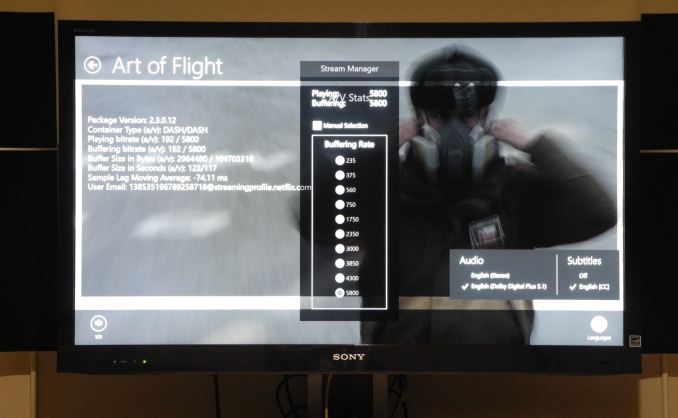The NVIDIA GeForce GTX 750 Ti and GTX 750 Review: Maxwell Makes Its Move
by Ryan Smith & Ganesh T S on February 18, 2014 9:00 AM ESTHTPC Aspects : Network Streaming Performance
Windows 7-based HTPCs need hardware acceleration in both Adobe Flash and Microsoft Silverlight for optimal streaming performance with YouTube and Netflix. The move to Windows 8.1 has made Silverlight unnecessary. The Netflix app on Windows 8.x brings a HTPC's capability on par with dedicated streaming consoles, with support for Super HD (6 Mbps) streams as well as Dolby Digital Plus bitstreaming support. The latest app also renders the video in such a way as to make taking screenshots an exercise in frustration.
As the above photograph shows, the Netflix app can be set to bitstream Dolby Digital Plus to the AV receiver and the 750Ti supports it. The video and audio streams are at 5.8 Mbps and 192 kbps respectively. It is not immediately evident as to whether GPU acceleration is being utilized. However, tracking the GPU / VPU loading and PC power consumption numbers make it obvious that it is not software decode at work in the Netflix app.
Unlike Silverlight, Adobe Flash continues to maintain some relevance right now. YouTube continues to use Adobe Flash to serve FLV (at SD resolutions) and MP4 (at both SD and HD resolutions) streams. YouTube's debug OSD indicates whether hardware acceleration is being used or not.
Similar to our Netflix streaming test, we recorded GPU / VPU loading as well as power consumption at the wall when streaming the 1080p version of the sample YouTube clip. The table below presents the relevant numbers for various configurations and streaming services.
| Streaming Video Performance | ||||||
| Netflix | YouTube | |||||
| GPU/VPU Load | Power | GPU/VPU Load | Power | |||
| NVIDIA GeForce GTX 750 Ti | 11.95/12.65% | 56.44 W | 16.26/15.74% | 55.45 W | ||
| NVIDIA GeForce GT 640 | 5.99/25.80% | 58.89 W | 15.57/25.72% | 58.93 W | ||
| AMD Radeon HD 7750 | 0.72% | 66.79 W | 3.57% | 67.11 W | ||
NVIDIA has been touting Maxwell's low power nature, and it proves to be the best of the three candidates in terms of power efficiency when it comes to GPU support for streaming services.












177 Comments
View All Comments
rish95 - Wednesday, February 19, 2014 - link
Yes. You can run PCIe 3.0 cards on 2.0 slots.rish95 - Wednesday, February 19, 2014 - link
This card is quite literally jesus for me. I've been waiting for something like this for a few years now.Currently I'm running an Athlon II X4 with a GT 240 on an OEM 250W PSU. I know it sounds like that may be a bit much for the PSU, but it's been working fine for years.
There haven't been any cards without external power connectors released since the GT 240 that have been significantly faster. I know I could have jumped to an HD 7750, but it's still not that much of an improvement. Now I can get a massive 3-4X performance boost without upgrading my PSU.
I hope this was worth the wait. I've had a copy of Crysis 3 for some time that I couldn't use because the 240 doesn't support DX11.
cbrownx88 - Wednesday, February 19, 2014 - link
Good for you man! This does sound like quite the fit! Hope your power supply keeps hangin in there!Antronman - Wednesday, February 19, 2014 - link
These cards will barely be able to run Crysis 3.rish95 - Wednesday, February 19, 2014 - link
Did you even read the review? It seems to manage 36 FPS at high settings at 1080p.I don't need Very High and I don't need 60 FPS. I just need it to look pretty good and run at a playable frame rate at native res.
This does seem to fit the bill.
Qwertilot - Thursday, February 20, 2014 - link
The only worry in some ways is that the 20nm version of this is inevitably going to be non trivially better at the same sort of power draw. I guess it isn't at all certain if they'll do a roughly equivalent one now though. Obviously not terribly soon. Might end up skipping to 16nm or something.HighTech4US - Wednesday, February 19, 2014 - link
Quote: NVIDIA is making a major effort to target GTX 550 Ti and GTS 450 owners as those cards turn 3-4 years old, with the GTX 750 series able to easily double their performance while reducing power consumption.And they have gotten me to upgrade my HTPC GPU that was on an EVGA GTS 450 to a brand new EVGA 02G-P4-3753-KR GeForce GTX 750 Ti Superclocked 2GB which I just purchased on Newegg for $160.38.
http://www.newegg.com/Product/Product.aspx?Item=N8...
This card is factory overclocked at Core Clock: 1176MHz Boost Clock: 1255MHz has a DisplayPort connector and a better copper heat assisted heat sink and fan shroud that exits some of the heat out the back bracket.
I will be selling my old EVGA GTS 450 on eBay and should clear $60 so I will have a very nice card for the next 3-4 years for an upgrade price of around $100. Not bad at all.
pierrot - Wednesday, February 19, 2014 - link
Awesome this ITX friendly size is the standard, just need power nowninjaquick - Thursday, February 20, 2014 - link
As neat as this is, it only proves that Maxwell scales within its TDP. It is consistent where it is at.devdollers@gmail.com - Friday, February 21, 2014 - link
wow..............